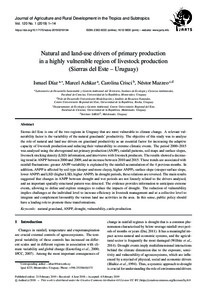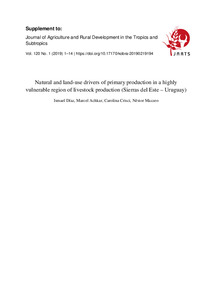| dc.date.accessioned | 2019-02-25T13:36:47Z | |
| dc.date.available | 2019-02-25T13:36:47Z | |
| dc.date.issued | 2019-02-21 | |
| dc.identifier | doi:10.17170/kobra-20190219194 | |
| dc.identifier.uri | http://hdl.handle.net/123456789/11079 | |
| dc.description | Gedruckte Ausg. im Verlag Kassel Univ. Press (www.upress.uni-kassel.de) erschienen. | |
| dc.language.iso | eng | |
| dc.rights | Urheberrechtlich geschützt | |
| dc.rights.uri | https://rightsstatements.org/page/InC/1.0/ | |
| dc.subject | natural grassland | eng |
| dc.subject | ANPP | eng |
| dc.subject | drought | eng |
| dc.subject | vulnerability | eng |
| dc.subject | cattle production | eng |
| dc.subject.ddc | 630 | |
| dc.title | Natural and land-use drivers of primary production in a highly vulnerable region of livestock production (Sierras del Este – Uruguay) | ger |
| dc.type | Aufsatz | |
| dcterms.abstract | Sierras del Este is one of the two regions in Uruguay that are most vulnerable to climate change. A relevant vulnerability factor is the variability of the natural grasslands’ productivity. The objective of this study was to analyse the role of natural and land use drivers on grassland productivity as an essential factor for increasing the adaptive capacity of livestock production and reducing their vulnerability to extreme climatic events. The period 2000–2015 was analysed using the aboveground net primary production (ANPP), rainfall patterns, soil maps and surface slopes, livestock stocking density (LSD) information, and interviews with livestock producers. The results showed a decreasing trend in ANPP between 2000 and 2009, and an increase between 2010 and 2015. These trends are associated with rainfall fluctuations: greater ANPP variability is explained by the rainfall accumulation of the 4 previous months. In addition, ANPP is affected by soil type (deeper and more clayey, higher ANPP), surface slope (steeper surface slope, lower ANPP) and LSD (higher LSD, higher ANPP). In drought periods, these relations are reversed. The main results suggested that changes in ANPP between drought and wet periods are not linearly related to the drivers analysed, and an important spatially structured pattern was detected. The evidence provides information to anticipate extreme events, allowing to define and explore strategies to reduce the impacts of drought. The reduction of vulnerability implies challenges at the individual level to increase efficiency in livestock management and at a collective level to integrate and complement favourably the various land use activities in the area. In this sense, public policy should have a leading role to promote these transformations. | eng |
| dcterms.accessRights | open access | |
| dcterms.creator | Díaz, Ismael | |
| dcterms.creator | Achkar, Marcel | |
| dcterms.creator | Crisci, Carolina | |
| dcterms.creator | Mazzeo, Néstor | |
| dc.type.version | publishedVersion | |
| dcterms.source.identifier | ISSN 1612-9830 | |
| dcterms.source.identifier | ISSN 2363-6033 | |
| dcterms.source.issue | No. 1 | |
| dcterms.source.journal | Journal of Agriculture and Rural Development in the Tropics and Subtropics (JARTS) | |
| dcterms.source.pageinfo | 1-14 | |
| dcterms.source.volume | Vol. 120 | |


